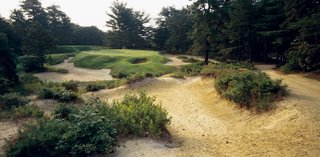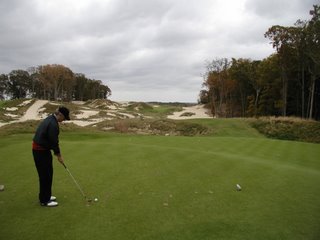Collaboration

Pine Valley, the greatest collaboration in golf
I had a recent chance to play a course that I still think is the best I have seen. The day I was set up to play, was during one of those periods where my game was just not sharp (and I had very few answers for it). I showed up in the morning to find out my caddie had been caddying at the course for 40 plus years. I made an unusual choice for me (I don’t give away control easily), and said you not only have my bag but I’m also going to let you make every decision today too (never done this before). I told him I would like to spend the round looking at the architecture, and if there is something you would like to show me about the course, please take the time to point it out to me. That was my second smart move; my caddie pointed out many things that I had missed on my first trip, primarily by looking backwards to understand the influential slopes. They were more apparent backwards as it turned out. I had also told him right up front that score doesn't matter, and all I hoped for was a couple of memorable shots that I could fondly remember. At the first tee he looked at me with a great deal of curiosity and suspicion, but proceeded to hand me clubs, which I simply swung till I was done all 18. I had more great moments than I would have expected; but more importantly I found I had simply soaked in the day (and most importantly the nuances of the course).
This wonderful experience got me thinking about the value of collaboration in golf beyond the player caddie relationship. The obvious relationship is the architect and shaper. Everyone knows that an architect is great assisted by the abilities of the shaper. In many cases the shaper has more skill than the architect and spends his time making a bad architect look good. In the ideal situation they become co-designers where the architect brings the way he wants to dictate play and a concept of what he want to see. The shaper brings an eye to how to lay this concept in the land and how to make the adjustments to the land appear natural. I can name every good shaper I worked with for the last 15 years and how most take their coffee.
The next thought is the great examples of collaborating architects and the great work they produced. Pine Valley is the site of the greatest known collaboration in Golf Architecture history. Look how many great minds contributed to such a great course. George Crump may have had the final say on what we know as Pine Valley, but the ideas of so many great minds, help make up the greatest collection of holes on one course.
The 10th at Friar's Head, a great par three
The second type of collaboration is of two architects who choose to work together to make better courses. Thomas and Bell, Colt and Allison are two of the greatest teams that come to mind. There is no question in my mind that Crenshaw and Coore is the leading architecture firm of our current era. The reason for this is that Bill and Ben not only trust each other, but they trust everyone else’s instincts who work for them. They allow the creative people that they work with enough room to bring additional ideas to the design. That is why they build better work than other firms.
So why do so many modern architects have such a need to lead the company rather than to collaborate? Dana Fry has suggested it may insecurity, I think it is the opposite reason, ego. His office is well known for their charette approach to designing golf courses. The layout that has the best routing gets built regardless of who routed it, or if it was worked on by a series of different people. Yet many other architects control it all. I left Carrick Design because that was Doug’s approach, we were allowed minor imput but that was really it. I don’t think it was insecurity, I think it is more likely that he become so sure of his design ideas that he was not interested in exploring other alternatives. Before you dump on Doug or others in that group, you must realise how many great architects did operate this way. I know through a couple of anecdotes that Stanley Thomson was not interested in any suggestions from his staff. Like everything else there are two ways to do things, I myself would enjoy the opportunity to collaborate with another architect, it would be another great learning experience. Others perfer to go it alone.

2 comments:
What about the unintentional collaboration of architects? Where one starts and another finishes? Or when one does a layout and another does a significant re-model? Sometimes those seem to work and other times. . . ?
Bob,
It would be fun to look at the results and dcide whether that was for the better or not, Stonewall by Doak is a Fazio routing, The Rock by Faldo was a David Moote routing.
Post a Comment